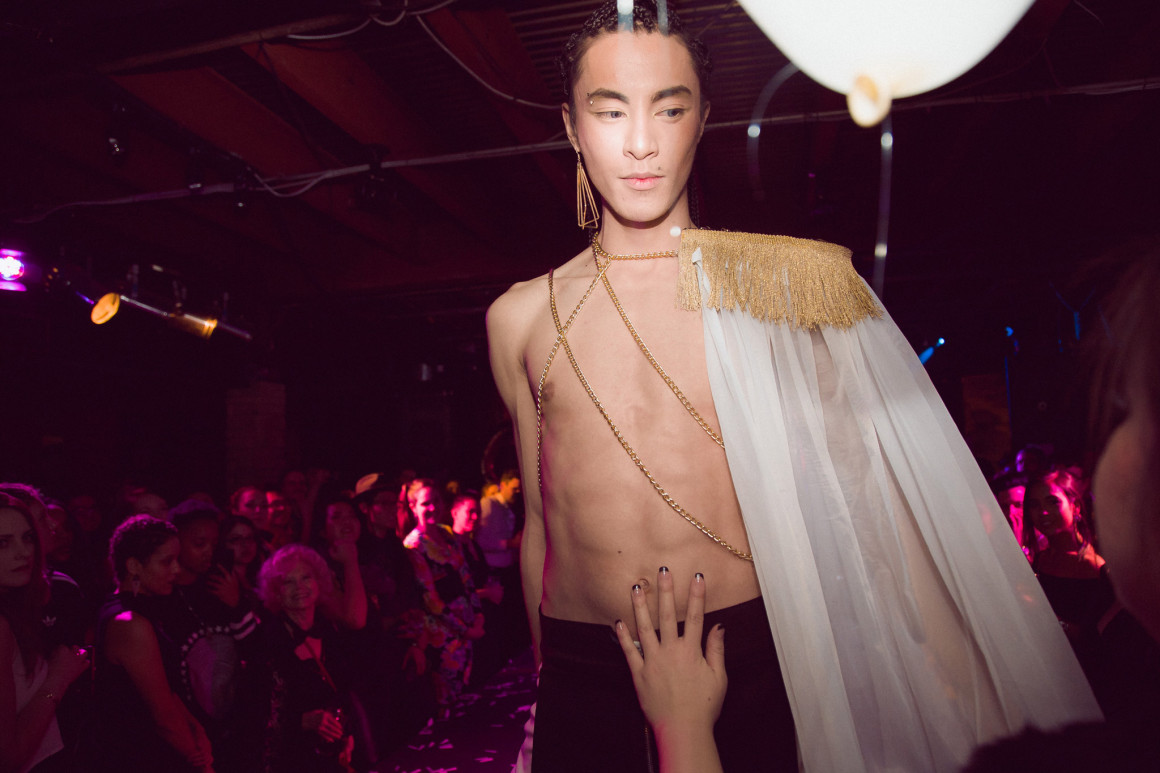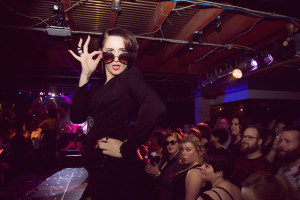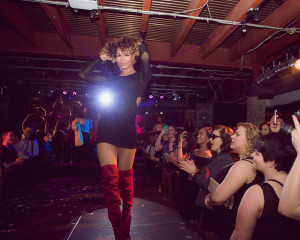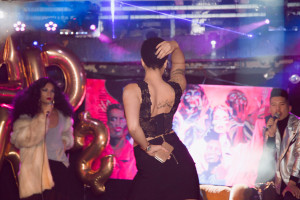
That’s Not What It’s Like In The World: Vogue Balls and Calgary’s LGBTQ Community
By Emily Leedham, February 4 2016 —
I feel like a golden disco ball riding the C-train downtown. My wedding ring, normally the glitziest part of my day-to-day flannel and jeans, is outshone by almost everything else on my body. My very short, very tight Forever 21 dress is covered in sequins and my very strappy, very high heels are covered in spikes. My nails are painted gold, and I’m feeling gay as hell on my way to a Vogue Ball.
Tony Tran is the founder and artistic director of The Bad Girls Club YYC, the group that organizes the annual Vogue Ball. He also works at a local non-profit and is a sessional dance instructor at the University of Calgary.
Tran took me to church the other day. Our holy text? Paris is Burning, a 1990 documentary exploring the birth of ballroom culture in New York City and the style of dance known as vogue — a mixture of runway catwalking, dance and street battle.
Vogueing serves as an entry into the rich history of LGBTQ people of colour. They created spaces and communities for themselves in a world that pushed them to the margins. Vogue Balls allow them to celebrate themselves and their communities in a way mainstream culture won’t.
But Calgary is not New York. Our ballroom scene is growing, but it can’t and won’t look like Manhattan in the ‘80s. I am hesitant to use the words and experiences of the New York vogue legends — mostly LGBTQ people of colour — in the context of Alberta’s community. But Tran assures me the legends of vogue intended to go global, and that ballroom culture provides valuable space for LGBTQ people around the world.
“The dance caught me first, that’s what grabbed me, and then everything else — there’s just so much more to this,” Tran said.
This year’s theme is opulence, juxtaposing excessive wealth and luxury with the LGBTQ experience in one of Canada’s wealthiest cities.
[hr gap=”30″]
Opulence
“I would like to be a spoiled rich white girl. They get what they want, whenever they want it. They don’t have to really struggle with finances and nice things and nice clothes, they don’t have to have that as a problem.” — Paris is Burning.
Moving from pose to pose like supermodels in the pages of Vogue Magazine soon became its own dance form. Following the release of Paris is Burning in 1990, Madonna popularized — some argue she appropriated — the dance with her song “Vogue.” The style has since seen a resurgence in mainstream popularity, with artists like FKA Twigs incorporating it into their videos.
The theory behind vogue is that many aspects of our identity — masculinity, femininity, sexuality, professionalism — are learned performances. The fact that our identities are performed doesn’t make them any less real, but this allows us to understand how what we do informs who we are. If you perform a role well enough at the Vogue Ball, you capture its realness. You are the role you perform.
Prior years saw performers cat-walking, dipping, duckwalking and dropping in the centre of an open dance floor with audience members crowding around to get a better look, screaming support for their favourites. But this year a runway, gloriously lit, commands the floor at Dickens Pub.
The outfits in the room vary. You can tell, based on their attire, whether a person plans to perform or if they are there to mingle and spectate. Capes, skirts, bowties, heels, sequins and makeup cross traditional gender boundaries. Several people are dressed in suits, ready to walk in the Executive Realness category, with headpieces and capes draped on those walking Haute Couture. Others wear silver and gold — the dress code to compete in the Old and New Way Vogue categories.
Michael Maher attends the ball every year, becoming a crowd favourite for his large stature and eclectic drag outfits. This year, he wore jeans, a t-shirt, a cardigan and a single glittery pendant around his neck. He worked all day and didn’t have the energy to put together an elaborate outfit — but that didn’t stop him from showing up.
“It’s one of the only big queer events I go to every year. It’s one of the events that I know will be majority queer, or will be majority queer and ally. And that’s really powerful, and really important,” Maher said.
The goal of walking in a category like Haute Couture is to embody the realness of a runway model. You might not be wearing high fashion, but can you make the judges believe you are? You might not have the body of a supermodel, but ‘owning’ the outfit counts for so much more.
“There’s a lot of wish fulfillment and dream fulfillment, I think, that takes place during a Vogue Ball,” Maher said. “You can inhabit a space that you don’t necessarily inhabit in your real life, or that you wish you could inhabit in your real life.”
Money — both having and not having it — always played an integral role in the ballroom scene. Ballroom culture initially involved a lot of DIY, but evolved over time to include luxury items and Haute Couture.
The scene asks questions of its participants — why should luxury be reserved for the rich? Why should extravagance be reserved for the straight and white?
“I say it’s vain because it’s all based on your look, your attire, how you carry yourself, the confidence that you have and being the best of the best,” Tran said. “But it’s also on the opposite end where it’s an inclusive, safe place, accepting, regardless of what you have, because we have all dealt with the same issues at some point in our lives, to different degrees.”
[hr gap=”30″]
Executive Realness
“In real life you can’t get a job as an executive unless you have an education background and the opportunity. Now, the fact that you are not an executive is merely because of the social standing of life.”
Jay Z’s “Tom Ford” blasts as suited performers storm the runway for the Executive Realness category. Guest judge Leiomy Maldonado has choreographed for the likes of Britney Spears and Beyonce and is known as the Wonder Woman of vogue. She sits on a chair at the end of the runway, unimpressed, as emcees taunt the performers.
“We’re looking for realness,” Tran says. “Calgary, we’re a fucking oil city, you know how to do this shit well! Do it well.”
Tran stops the music.
“Hold up, hold up,” he says. “Executive Realness is about being masculine.”
Maldonado takes the mic.
“It’s all about selling your realness, and realness is based on everyday society. You’re walking down the street and nobody’s gonna call you a fag. You gotta sell your testosterone.”
While the ballroom scene is a place where LGBTQ individuals can celebrate their own identities — demanding the spotlight in a world that prefers the closet — the Vogue Ball also turns seamless integration into an art form. Many LGBTQ individuals have to pass for straight or gender-conforming to navigate daily life in Alberta, especially in the workplace.
For Quinn Nelson, a trans non-binary sociology student at the U of C, employment is often precarious. Nelson works in retail. While they think the industry is one of the more trans-friendly working environments, it’s not ideal. Minimum wage, unpredictable hours and lack of benefits or sick days can be even more detrimental for trans individuals who experience higher rates of discrimination, mental illness and lack of social support.
The expense of owning a car is not always practical when you work in retail, making public transit the more cost-effective alternative. But for someone like Nelson, whose gender presentation shifts on a day-to-day basis, public transit is often a source of anxiety.
Corporate jobs that provide economic stability can be even less friendly for trans people. While statistics about trans and non-binary people are sparse, a recent study in Ontario found that 13 per cent of trans individuals had been fired for being trans, while 17 per cent turned down job offers to avoid non trans-friendly environments.
And what does “business casual” even mean in 2016? How do you dress for an interview? If you choose to transition in a corporate environment, buying a new professional wardrobe is extremely costly.
Executive Realness highlights what LGBTQ people must do to navigate their daily lives.
The music starts up again — Justin Timberlake’s “Suit and Tie.”
“Come on, who makes the most money?” Tran says.
The winner is clean-cut, sporting a plain suit, glasses and a moustache. He walks the runway looking down at his Blackberry, pausing only to reach down and kiss my gold nail-polished hand.
[hr gap=”30″]
Town and Country
“You go in there and you feel 100% right being gay — that’s not what it’s like in the world.”
We’ve moved into the performance categories, where dancers are battling in pairs to show off their New Way Vogue moves. Gold and silver outfits are outshone by the diversity of the performers themselves.
You wouldn’t guess it from the Vogue Ball, but Calgary’s LGBTQ community has a diversity problem. Tran believes that while Calgarians are more supportive of the LGBTQ community than ever, acceptable forms of presentation are still narrow. He said diversity is not simply accepting people’s identities, but recognizing that the LGBTQ community itself is diverse, with many different needs based on factors like race and economic status.
Haider Ali, an International Relations student at the University of Calgary, came out as gay to his parents just over a year ago. He said their response wasn’t ideal, and Ali reached out to the Q Centre on campus for support.
“I wanted to gain access to resources that helped me communicate my sexual orientation to my mom in a religious context to get past the whole “yeah, but you’re Muslim” thing,” he said.
Another prominent resource for the LGBTQ community, Calgary OutLink, recently dissolved after a messy dispute led to accusations of structural racism. The organization operated in Calgary for 25 years. OutLink is rebuilding, and will hopefully emerge with a stronger mandate to address racism in the community.
 Supporting diversity within the LGBTQ community can be as simple as breaking the acronym apart from time to time. Possibilities Calgary — a resource I found helpful when discovering my bisexuality — addresses bisexual and pansexual visibility within the LGBTQ community, but went dormant after founder Tiffany Sostar took time off to recover from burnout — a common experience among activists.
Supporting diversity within the LGBTQ community can be as simple as breaking the acronym apart from time to time. Possibilities Calgary — a resource I found helpful when discovering my bisexuality — addresses bisexual and pansexual visibility within the LGBTQ community, but went dormant after founder Tiffany Sostar took time off to recover from burnout — a common experience among activists.
Sostar is slowly reviving Possibilities, hoping to create a more sustainable organization and recruit others to help her with administrative tasks.
Cost can also bar Calgarians from engaging with the LGBTQ community. Maher wants more LGBTQ-friendly spaces so the community doesn’t feel like a clique. He said sliding-scale entry fees, encouraging food bank donations or organizing events outside of downtown could increase accessibility for those with fewer financial resources.
“I miss so many Hot Messes [an LGBTQ-friendly pop-up party] just because I can’t justify going to them if I need to buy train tickets or if I’m working,” Maher said.
It’s unreasonable to expect one organization or group to be able to provide resources for every single demographic in the LGBTQ community. Organizations are set up to fail when they have to be everything to everybody.
Tran started The Bad Girls Club YYC because he found himself more connected to the LGBTQ community through vogue than he did through other outlets. Like many before him, he traveled to New York City to learn the craft and culture from its legends before bringing it home to Calgary. While the Vogue Ball can’t be everything, he has created a brand new community for LGBTQ Calgarians to celebrate themselves and each other.
“I wanted to learn to dance. I wanted to perfect my form. I wanted to compete. Then I slowly realized there’s more to this,” Tran said. “I feel very included and I want to be a part of a house, not just to wear a name, but to feel like I have a network of people that can help me develop as a dancer and a voguer, but also to reach out to.”
[hr gap=”30″]
Calgary
“Shade is I don’t tell you you’re ugly, but I don’t have to tell you because you know you’re ugly.”
It’s 3:00 a.m. outside Dickens and I’m watching someone wrestle eight giant, gold balloons that spell “Bad Girls” into a cab. A truck drives up and stops at the red light. It’s blaring music, and my friends and I start dancing on the sidewalk. The two men in the car laugh and turn their music up even louder. The light turns green and the truck accelerates forward. One of them yells, “do you want my sausage?”
What I really want is a slice of tandoori pizza. But thanks for offering, I guess?
Since the NDP won the provincial election in May, people say Alberta is more liberal than we once thought. We’re the first major city in North America with a Muslim mayor. We elected two Liberal MPs last fall.
Calgary is changing, and so is Alberta. But liberals do themselves a disservice by ascribing progressive values to a population that, by and large, has yet to earn that label.
The economic anxiety driven by the drop in oil prices may be a new feeling for many Albertans, but financial insecurity is old news for the LGBTQ community.
According to the Parkland Institute, Alberta has the worst income inequality of any Canadian province, as well as the highest gender wage gap. Our minimum wage is $11.20 per hour, even though local non-profit Vibrant Communities Calgary calculates the city’s living wage as $17.29 per hour.
And income instability disproportionately effects trans and non-binary individuals. A recent study suggests 25–40 per cent of homeless Canadian youth identify as LGBTQ community members.
“When I was first coming out, I really wanted to leave Calgary,” Maher said. “Part of why I’ve stayed in Calgary and part of why I’ve managed to find community in Calgary is because I was too poor to move away by myself.”
And community is fundamental. Without it, people are more likely to have feelings of loneliness, alienation and depression. According to the Canadian Trans Youth Health Survey, more than 1 in 3 trans youth have attempted to take their own life.
If Maher had enough money, would he still move?
“Probably,” he said.
There are many things about Calgary that enrich the lives of people in the LGBTQ community — the feeling
of home, the mountains, friends and family. But Nelson thinks the city needs to address the structural economic barriers limiting trans people.
“Calgary is awful compared to other cities in Canada,” Nelson admits. “Alberta in general is just awful for queer quality of life.”
[hr gap=”30″]
Werk
“If I had the riches, I wouldn’t enjoy having a whole lot of money, like being a millionaire and hoarding it, you know, I’d share it with all my loved ones, cause I’d want them to have it too.”
Reappropriation is a big part of Vogue Ball. Reclaiming words and notions traditionally used to ostracize, while utilizing depictions of luxury formerly unavailable to LGBTQ people, are important parts of establishing a sense of community.
“You have to show love, because without love there’s destruction. And we don’t want destruction,” Moldonado said. She believes Tran’s work with The Bad Girls YYC doesn’t only bring the aesthetic of vogue to Calgary, but respects its history and the importance of its community, too.
“I think the important thing for Calgary is to support a lot of these grassroots communities and to put in the work,” Tran said. “I don’t even think of it as the LGBTQ community. I think of Calgary as a whole.”
Tran refers to a Haskayne mentorship program he attended during his undergrad. Through monthly conversations with his mentor about his hobbies and interests, like vogue, his mentor was inspired to give her employees a health and wellness budget to promote a healthy work/life balance.
That story stayed with me. Tran’s experiences caused his mentor to make structural changes within her own company to improve the well-being of her employees.
“Be yourself, talk about what you do, celebrate what you do, because you never know the impact you can make in someone else’s life,” Tran said.
Opulence was born out of structural economic barriers that denied LGBTQ people of colour the lifestyles their straight white counterparts enjoyed. I look at the status of LGBTQ people in Alberta — still the richest province in Canada — and find the current situation wanting.
What we need is a dose of progressive realness.
This article originally incorrectly identified Hot Messes as a “night at popular LGBTQ-friendly club Twisted.” Hot Mess is an LGBTQ-friendly pop-up party that has no association with Twisted. The Gauntlet apologizes to our readers for this error.
